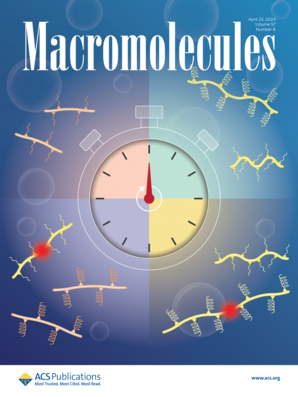分子结构对两性离子水凝胶缠结和力学的影响
IF 5.1
1区 化学
Q1 POLYMER SCIENCE
引用次数: 0
摘要
两性离子水凝胶具有优异的抗蛋白质吸附性能,作为植入材料具有很大的潜力。然而,由于多两性离子的超强水化能力,导致水化链之间的弱结合,因此对这些凝胶的增韧仍然是一个很大的挑战。本文通过将苯-亚甲基-咪唑基序编程到两性离子片段中并调节其缔合行为,制备了一种兼具韧性和蛋白质抗性的两性离子水凝胶。发现苯和咪唑对阴离子基的水化没有干扰,但它们改变了阳离子基周围的水配位壳,从而形成致密的两性离子对。利用1H NMR技术和MD模拟,揭示了它们之间的苯、咪唑和亚甲基是促进反应的关键基团,特别是在高单体浓度下。其中咪唑类药物为主要因素。然后,紧密结合的单体有利于聚合成高度纠缠的网络,有助于同时提高杨氏模量、韧性和回弹性。同时,不牺牲两性离子凝胶的典型特性,具有较高的蛋白质吸附阻力。这项工作为两性离子凝胶的化学和机械设计提供了新的见解。本文章由计算机程序翻译,如有差异,请以英文原文为准。

Effect of Molecular Structures on Entanglements and Mechanics of Zwitterionic Hydrogels
Zwitterionic hydrogels have great potential as implant materials due to their excellent resistance to protein adsorption. However, it remains a great challenge to toughen these gels owing to the ultrastrong hydration capability of polyzwitterions, which leads to weak associations between hydrated chains. Herein, a zwitterionic hydrogel with integration of toughness and protein resistance was developed by programming the benzene–methylene–imidazolium motif into the zwitterionic moiety and regulating its association behavior. It was found that the benzene and imidazolium did not interfere with the hydration of the anionic group, yet they changed the water coordination shell around the cationic group to allow the formation of compact zwitterion pairs. Taking advantage of 1H NMR technology and MD simulation, all of the benzene, imidazolium, and methylene between them were revealed as key moieties that facilitate the associations, especially at high monomer concentrations. Among them, the imidazolium was proven to be the predominant factor. Then, the densely associated monomers were conducive to polymerizing into a highly entangled network, contributing to simultaneous improvements in Young’s modulus, toughness, and resilience. Meanwhile, the typical characteristics of a zwitterionic gel were not sacrificed, showing high resistance to protein adsorption. This work provides new insights into the chemical and mechanical design of the zwitterionic gels.
求助全文
通过发布文献求助,成功后即可免费获取论文全文。
去求助
来源期刊

Macromolecules
工程技术-高分子科学
CiteScore
9.30
自引率
16.40%
发文量
942
审稿时长
2 months
期刊介绍:
Macromolecules publishes original, fundamental, and impactful research on all aspects of polymer science. Topics of interest include synthesis (e.g., controlled polymerizations, polymerization catalysis, post polymerization modification, new monomer structures and polymer architectures, and polymerization mechanisms/kinetics analysis); phase behavior, thermodynamics, dynamic, and ordering/disordering phenomena (e.g., self-assembly, gelation, crystallization, solution/melt/solid-state characteristics); structure and properties (e.g., mechanical and rheological properties, surface/interfacial characteristics, electronic and transport properties); new state of the art characterization (e.g., spectroscopy, scattering, microscopy, rheology), simulation (e.g., Monte Carlo, molecular dynamics, multi-scale/coarse-grained modeling), and theoretical methods. Renewable/sustainable polymers, polymer networks, responsive polymers, electro-, magneto- and opto-active macromolecules, inorganic polymers, charge-transporting polymers (ion-containing, semiconducting, and conducting), nanostructured polymers, and polymer composites are also of interest. Typical papers published in Macromolecules showcase important and innovative concepts, experimental methods/observations, and theoretical/computational approaches that demonstrate a fundamental advance in the understanding of polymers.
 求助内容:
求助内容: 应助结果提醒方式:
应助结果提醒方式:


